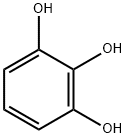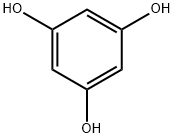Pyrogallic , >99.0%(GC) , 87-66-1
Synonym(s):
1,2,3-Trihydroxybenzene;2,3-Dihydroxyphenol;Pyrogallic acid;Pyrogallic acid, 1,2,3-Trihydroxybenzene;Pyrogallol
CAS NO.:87-66-1
Empirical Formula: C6H6O3
Molecular Weight: 126.11
MDL number: MFCD00002192
EINECS: 201-762-9
| Pack Size | Price | Stock | Quantity |
| 100G | RMB57.60 | In Stock |
|
| 500G | RMB228.00 | In Stock |
|
| 2.5kg | RMB860.80 | In Stock |
|
| others | Enquire |
PRODUCT Properties
| Melting point: | 43-47 °C(lit.) |
| Boiling point: | 309 °C |
| Density | 1.112 g/mL at 25 °C(lit.) |
| bulk density | 600kg/m3 |
| vapor density | 4.4 (vs air) |
| vapor pressure | 10 mm Hg ( 167.7 °C) |
| refractive index | n |
| Flash point: | >230 °F |
| storage temp. | Store below +30°C. |
| solubility | water: soluble |
| form | Very Fine Crystalline Powder |
| pka | pK1:9.03(0);pK2:11.63(+1) (25°C) |
| color | White |
| PH | 4-5 (50g/l, H2O, 20℃) |
| Water Solubility | 400 g/L (25 ºC) |
| Sensitive | Light Sensitive |
| Merck | 14,8000 |
| BRN | 907431 |
| Stability: | Stable, but decolourises in light. Combustible. Incompatible with strong oxidising agents, alkalies, metal oxides, ammonia, antipyrine, phenol, iodine, lime water, menthol, potassium permanganate, strong bases. |
| InChIKey | WQGWDDDVZFFDIG-UHFFFAOYSA-N |
| LogP | -0.47 |
| CAS DataBase Reference | 87-66-1(CAS DataBase Reference) |
| NIST Chemistry Reference | 1,2,3-Benzenetriol(87-66-1) |
| EPA Substance Registry System | Pyrogallol (87-66-1) |
Description and Uses
Pyrogallol is a natural oxidant that can generate superoxide (O2-) in alkaline solutions through autoxidation to a semiquinone radical. Importantly, the semiquinone radical can react with O2- in an acidic environment to produce a quinone and H2O2. Pyrogallol autoxidation is used in superoxide dismutase activity assays. It can also be used in assays to assess antioxidant capacity. Pyrogallol is used in some biological systems as an O2- scavenger. In other biological systems, it is used as an O2- generator. Pyrogallol effectively scavenges DPPH radical and ABTS+ in vitro. Pyrogallol is a product of tannin degradation to gallic acid by ruminant microbes and has hepatotoxic and nephrotoxic effects in vivo.
Complexing agent; reducing agent; alkaline solution indicator for gaseous oxygen.
Safety
| Symbol(GHS) |   GHS07,GHS08 |
| Signal word | Warning |
| Hazard statements | H302+H312+H332-H341-H412 |
| Precautionary statements | P273-P280-P301+P312-P302+P352+P312-P304+P340+P312-P308+P313 |
| Hazard Codes | Xn |
| Risk Statements | 20/21/22-52/53-68-40-36/38 |
| Safety Statements | 22-24/25-61-36/37-26 |
| RIDADR | UN 2811 6.1/PG 3 |
| WGK Germany | 3 |
| RTECS | UX2800000 |
| F | 8 |
| TSCA | Yes |
| HS Code | 2907 29 00 |
| HazardClass | 6.1 |
| PackingGroup | III |
| Hazardous Substances Data | 87-66-1(Hazardous Substances Data) |
| Toxicity | LD50 orally in rabbits: 1.6 g/kg (Dollahite) |



